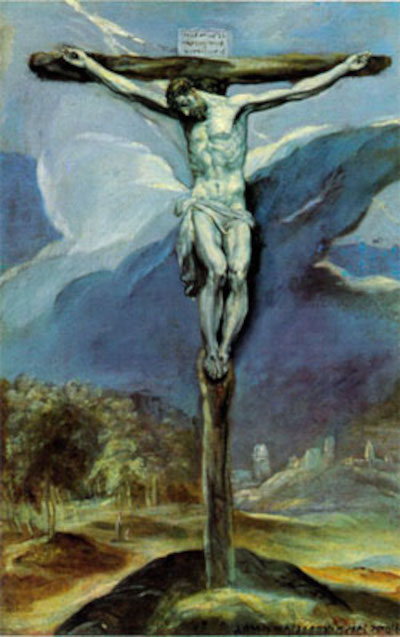Relatively little is known about this El Greco painting from 1573. It came right at the end of his time in Italy, just before his move across to Spain. The piece is linked to the Barbara Pyasetskaya-Johnson Collection, Princeton, but its current location could not be determined.
Certain religious themes within his career would appear many times over, and Christ on the Cross would be one of those. This particular version is relatively small, at only 43cm × 28cm. It may well have been a private commission for a devotional piece, to be hung within someone's home, because of the content involved and the size of the painting itself. We find Christ hanging limply from the cross, with his arms outstretched in the iconic image which even non-Christians will be well aware of. The scene from the Bible would become one of religion's most re-used topics, bringing drama and emotion to the canvas like no other theme. El Greco himself was very religious, and so would have enjoyed focusing on this type of content which formed the backbone of his faith. The image captures a detailed view of Christ's skinny body as he looks in a desperate situation. Behind him is landscape scene, with groups of trees bunched up on one side, and a view of a small town on the other. Above are dramatic cloud formations which add to the mood of this painting.
In terms of related artworks, around which more information would likely be available, you might also want to check out the likes of Crucifixion, The Disrobing of Christ and also Christ Carrying the Cross. Artists within the Renaissance had captured scenes from the life of Jesus Christ for several centuries before the arrival of El Greco, and so he was just following in the footsteps of others in that regard. What was different, however, was in how he delivered these scenes, with extraordinary drama and expression which differed to most other artists of that era. This brought him popularity, and also ensured a steady stream of commissions throughout his life. Despite his relatively contemporary approach, El Greco was still able to please religious figures in most cases, and actually had too much of a workload, if anything. He eventually grew his workshop in order to cater to these increased demands.
The piece may not be the most famous El Greco artwork, or even his best known piece on this particular topic, but it again reminds us of his ability to provide expression and emotion in a unique way. His colour tones helped to set the mood and many elements of this painting would continue into his later career, even after he had moved over to Spain. He remains regarded as one of the most interesting artists from that period, fusing the styles of different European art schools together to produce something interesting and fresh. Even today, his work looks a little different to what we are used to and the public continue to appreciate his combination of modern and traditional, with exhibitions of his work still fairly common over the past century or so.




